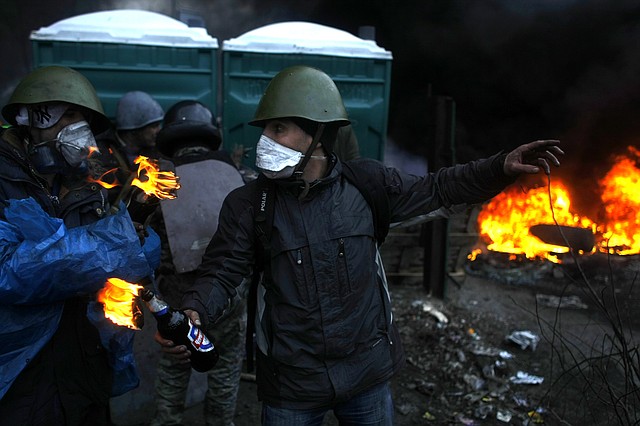Ukraine: Protesters capture 67 police in Kiev
Anti-government protesters get ready to throw petrol bombs on the outskirts of Independence Square in Kiev, Ukraine, Thursday, Feb. 20, 2014. Fierce clashes between police and protesters, some including gunfire, shattered a brief truce in Ukraine's besieged capital Thursday, killing numerous people. The deaths came in a new eruption of violence just hours after the country's embattled president and the opposition leaders demanding his resignation called for a truce and negotiations to try to resolve Ukraine's political crisis.
Thursday, February 20, 2014
KIEV, Ukraine — Fearing that a call for a truce was a ruse, protesters tossed firebombs and advanced upon police lines Thursday in Ukraine's embattled capital. Government snipers shot back and the melee that ensued left at least 33 people dead.
Video footage on Ukrainian television showed shocking scenes Thursday of protesters being cut down by gunfire, lying on the pavement as comrades rushed to their aid. Trying to protect themselves with shields, teams of protesters carried bodies away on sheets of plastic or on planks of wood.
Protesters were also seen leading policemen with hands held high around the sprawling protest camp in central Kiev — Ukraine's Interior ministry said 67 police were captured in all. They are being held in Kiev's occupied City Hall, an opposition lawmaker said.
An AP cameraman saw snipers shooting at protesters in Kiev and video footage showed that at least one sniper wearing a Ukraine riot police uniform.
President Viktor Yanukovych and the opposition protesters who demand his resignation are locked in a battle over the identity of Ukraine, a nation of 46 million that has divided loyalties between Russia and the West. Parts of the country, mostly in its western cities, are in open revolt against Yanukovych's central government, while many in eastern Ukraine favor strong ties with Russia, their former Soviet ruler.
At least 59 people have died this week in the clashes in Kiev, a sharp reversal in the three-month, mostly peaceful political crisis. Thursday was the deadliest day yet.
An Associated Press reporter saw 21 bodies Thursday laid out on the edge of the protest camp. Protest medic Andriy Huk later told the AP that 32 activists have been killed. In addition, one policeman was killed and 28 suffered gunshot wounds Thursday, Interior Ministry spokesman Serhiy Burlakov said.
Read tomorrow's Arkansas Democrat-Gazette for full details.
25640365
Key events in the unrest
Nov. 21: President Viktor Yanukovych's government announces that it is abandoning an agreement that would strengthen ties with the European Union and instead seeks closer cooperation with Moscow. Protesters take to the streets.
Nov. 30: Police brutally attack a group of protesters, detaining 35. Images of protesters bloodied by police truncheons spread quickly and galvanize public support for the demonstrations. A protest on Dec. 1 attracts about 300,000 people, the largest in Kiev since the Orange Revolution in 2004. Activists seize Kiev City Hall.
Dec. 17: Russian President Vladimir Putin announces that Moscow will buy $15 billion worth of Ukrainian government bonds and allow for a sharp cut in the price Ukrainians pay for Russian natural gas. Putin and Yanukovych claim there are no conditions attached.
Jan. 22: Two protesters die after being hit with live ammunition and the third after a fall during a confrontation between police and demonstrators manning barricades, the first protest deaths.
Jan. 28: The prime minister resigns and parliament repeals the new harsh anti-protest laws that set off the violence of a week earlier. Both are concessions to the opposition aimed at defusing the crisis.
Jan. 31: Opposition activist Dmytro Bulatov, missing since Jan. 22, resurfaces badly bruised and with part of his right ear cut off. He believes a pro-Russia group was behind his kidnapping and torture, raising fears among the opposition that extrajudicial squads are being deployed to intimidate protesters.
Feb. 16: Opposition activists end their occupation of Kiev City Hall in exchange for the release of all 234 jailed protesters, in what is seen as a sign of progress toward resolving the crisis peacefully.
Feb. 18: Street clashes leave at least 26 people, including 10 police officers, dead and hundreds injured. The violence begins when protesters attack police lines and set fires outside parliament after it stalls on taking up a constitutional reform to limit presidential powers. Russia's offer the day before to resume payments under the bailout deal also feeds opposition suspicions that Yanukovych has made a deal with Moscow to stand firm against the protesters. Riot police respond to the violence by trying to push protesters off Independence Square.
Feb. 20: Hours after a truce is announced, fierce clashes break out between protesters and police, with numerous casualties.
Information for this article was contributed by Maria Danilova, Jim Heintz and Yury Uvarov in Kiev.

